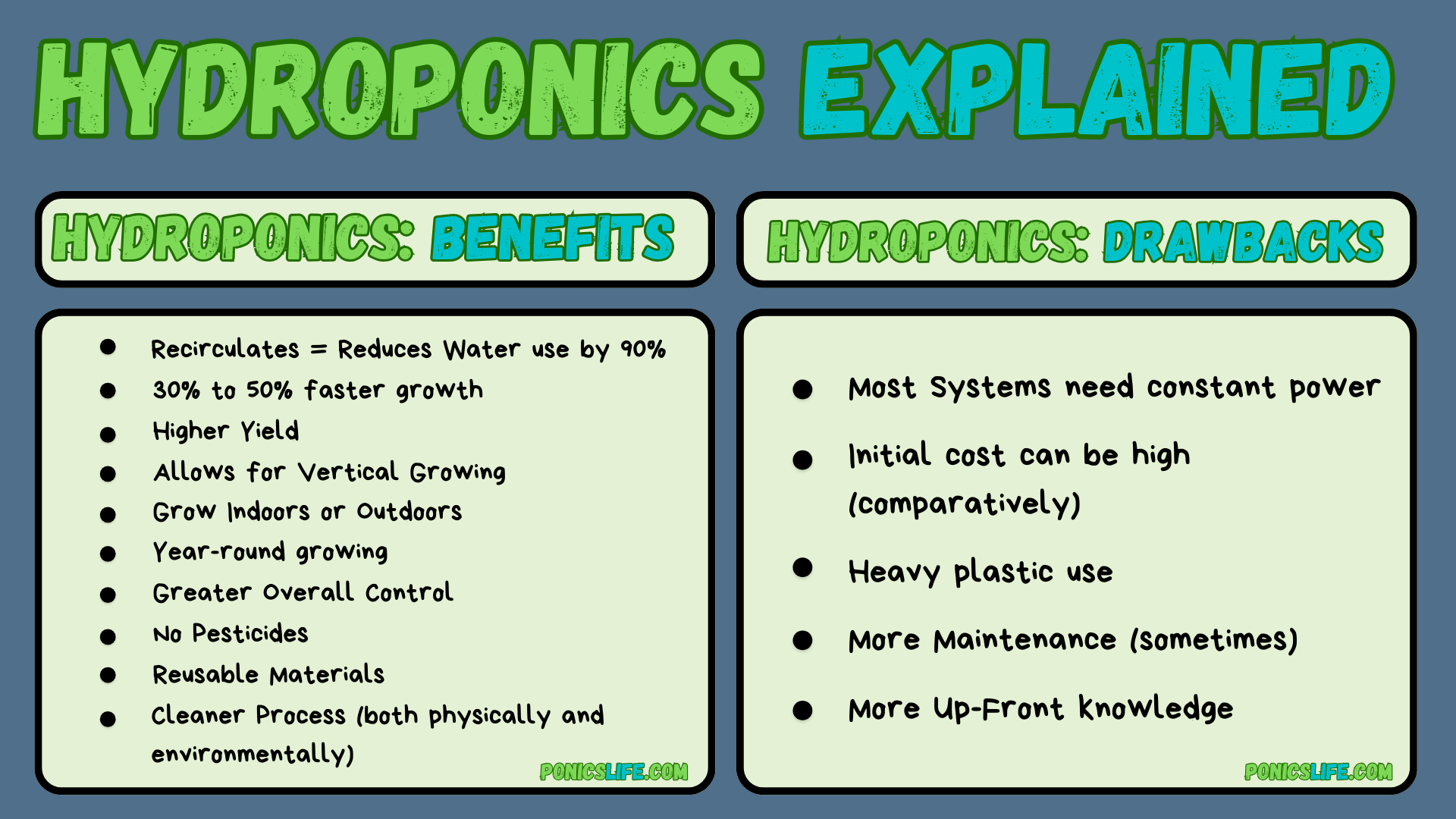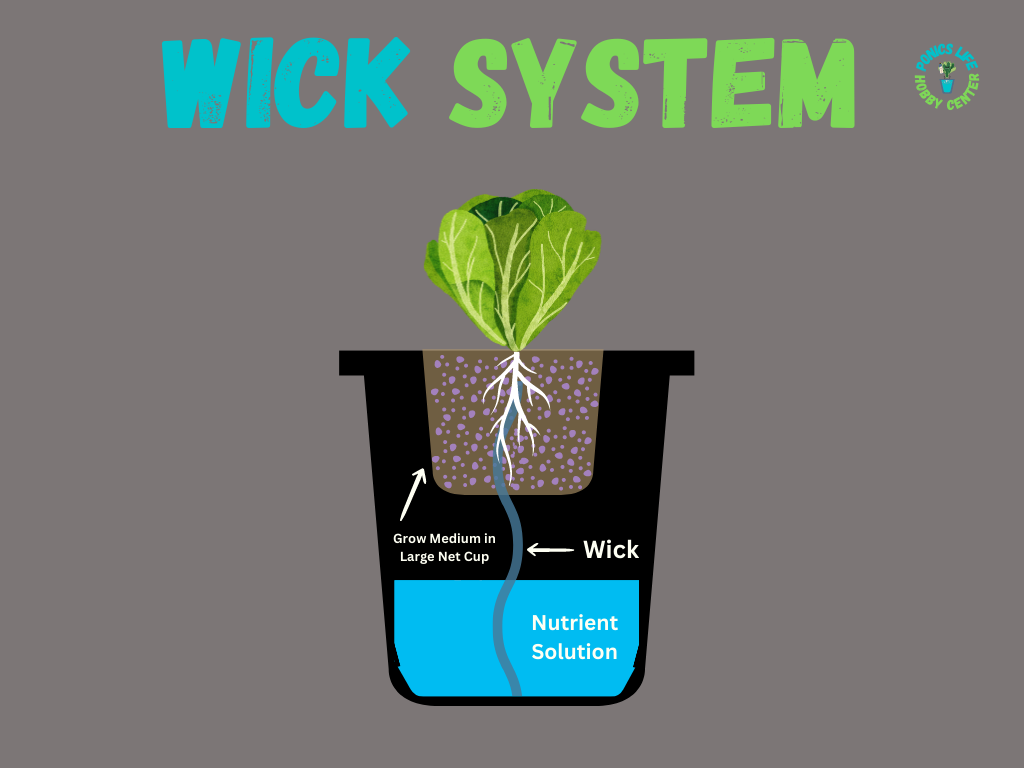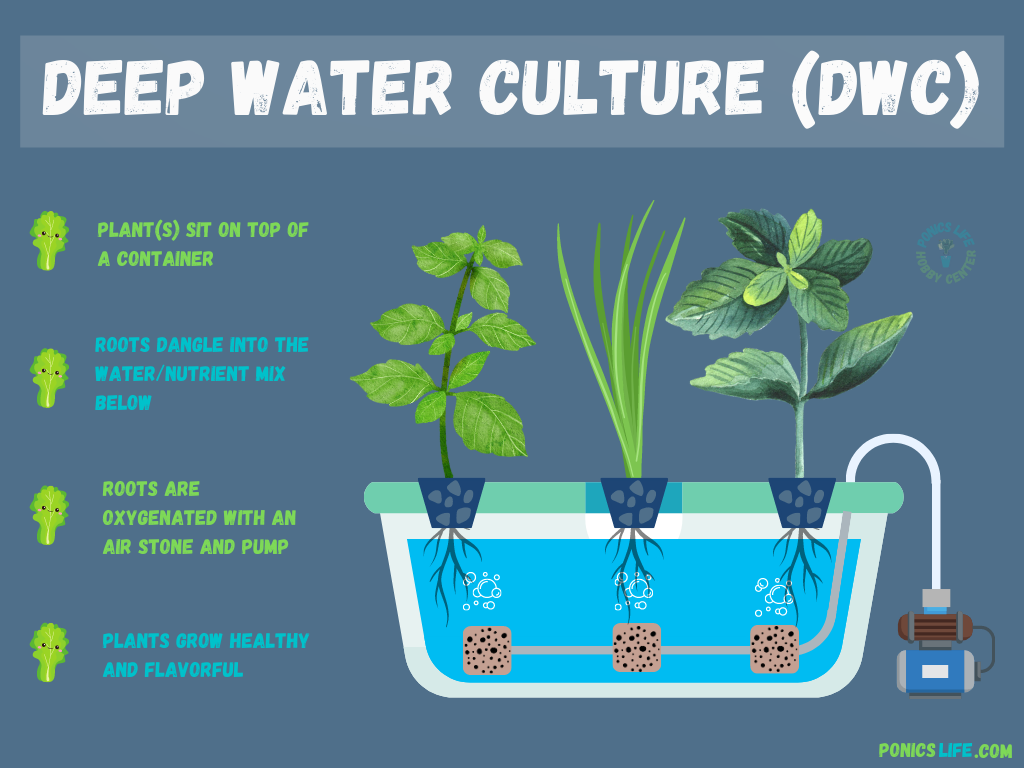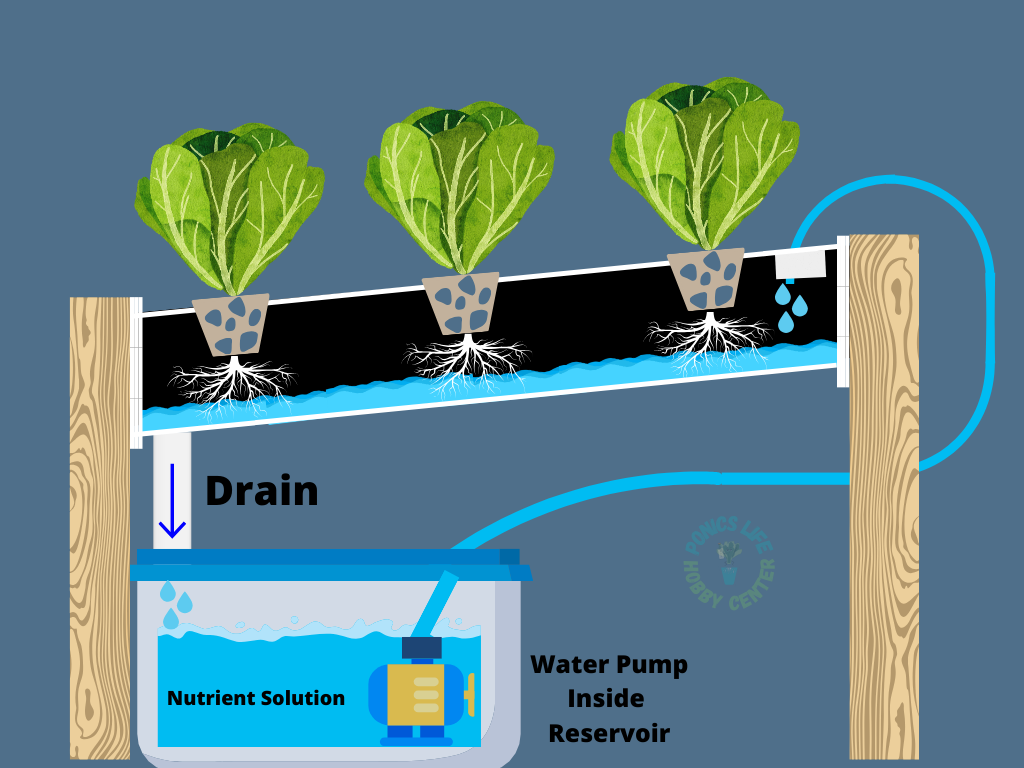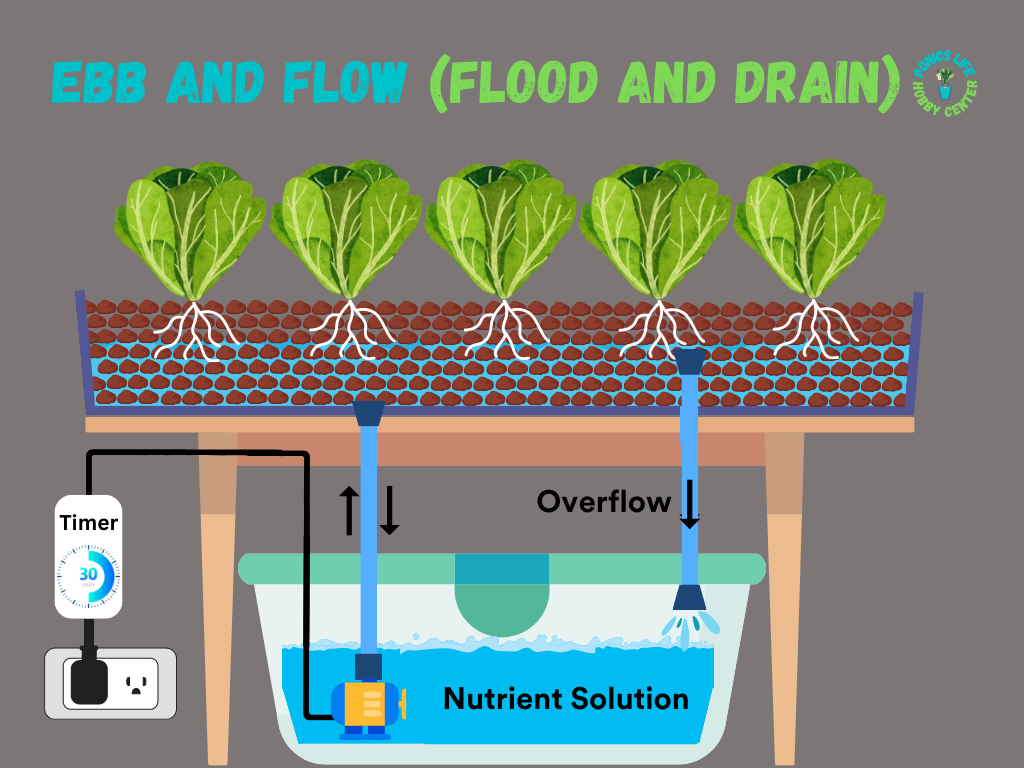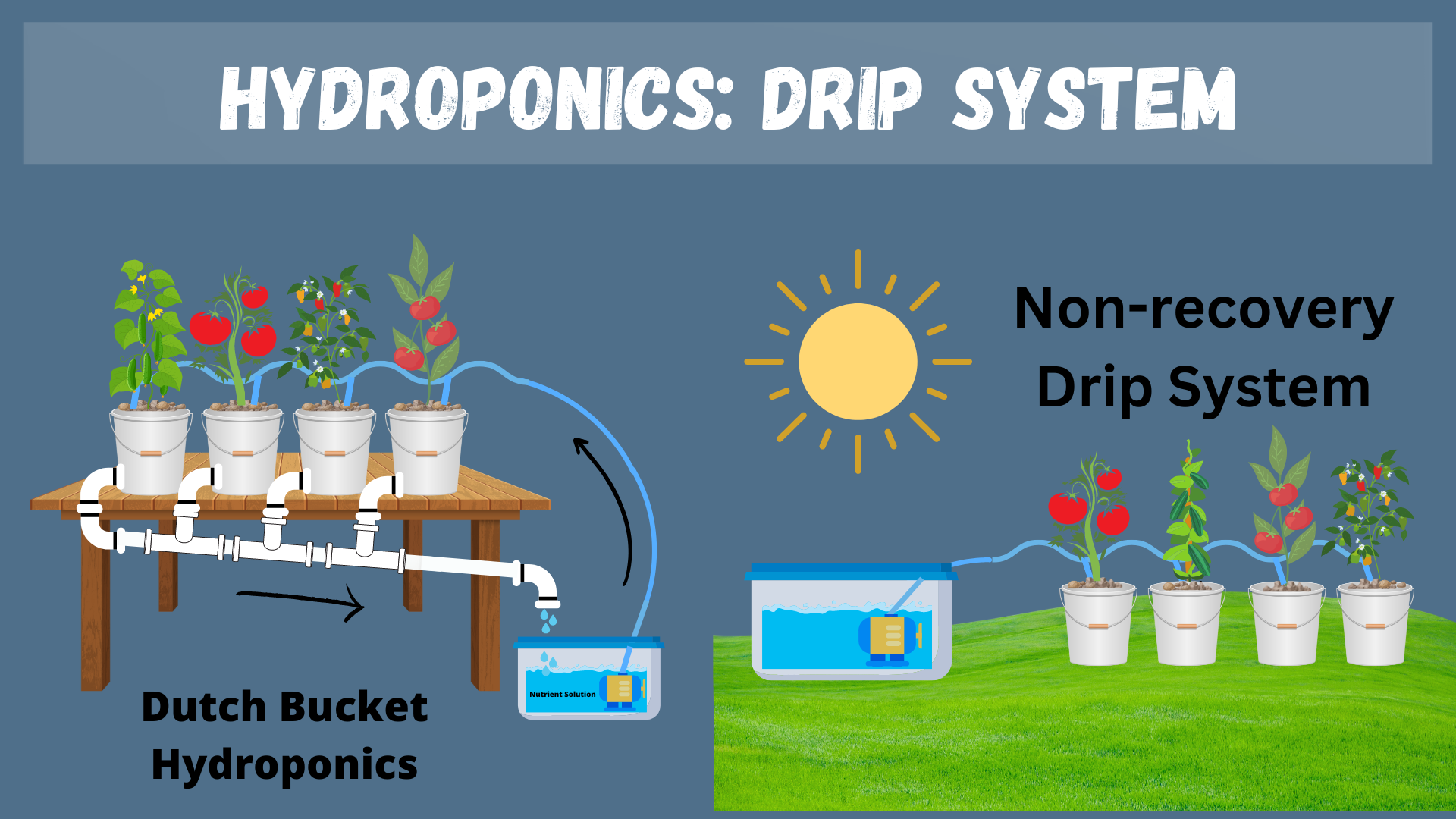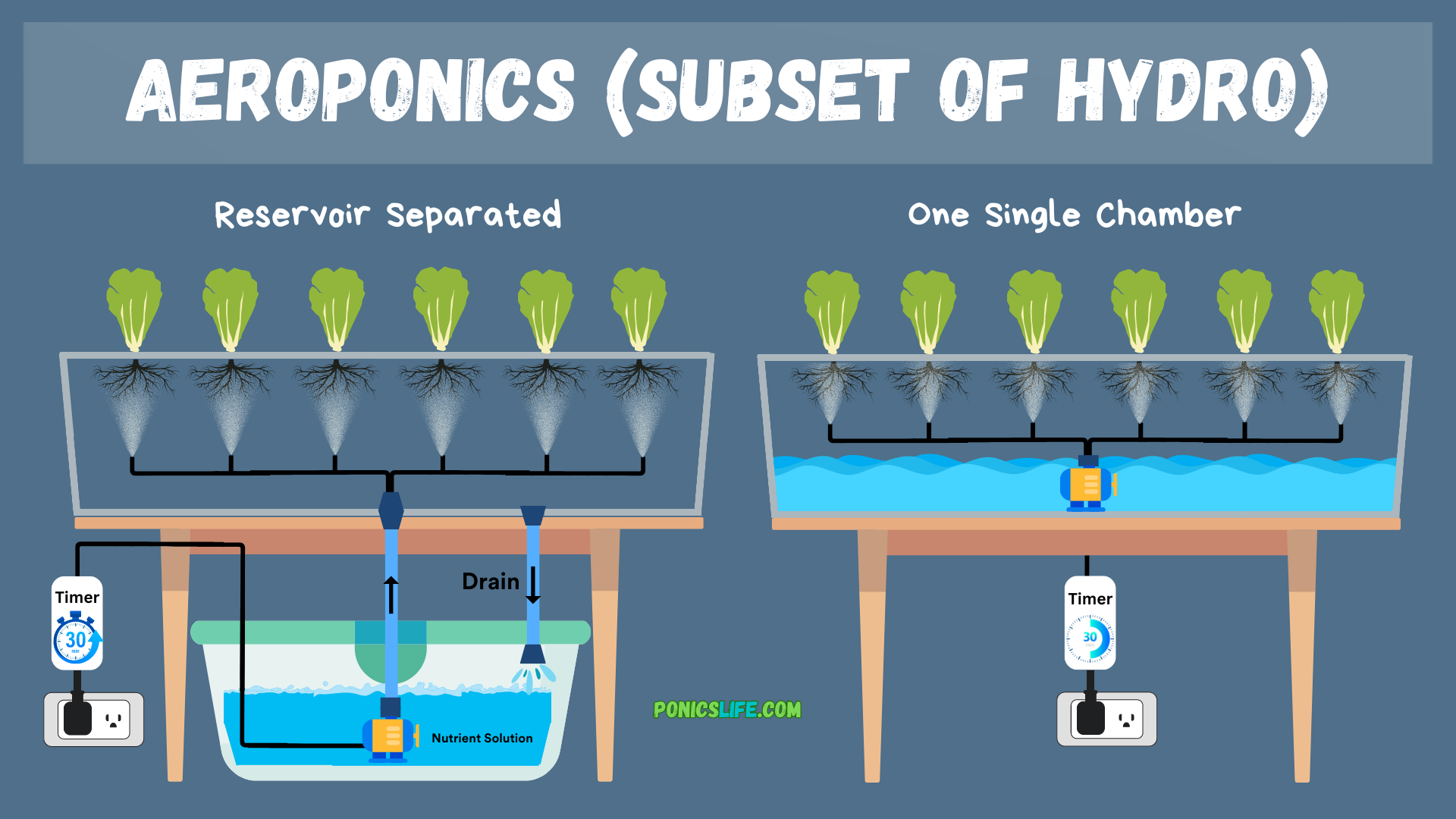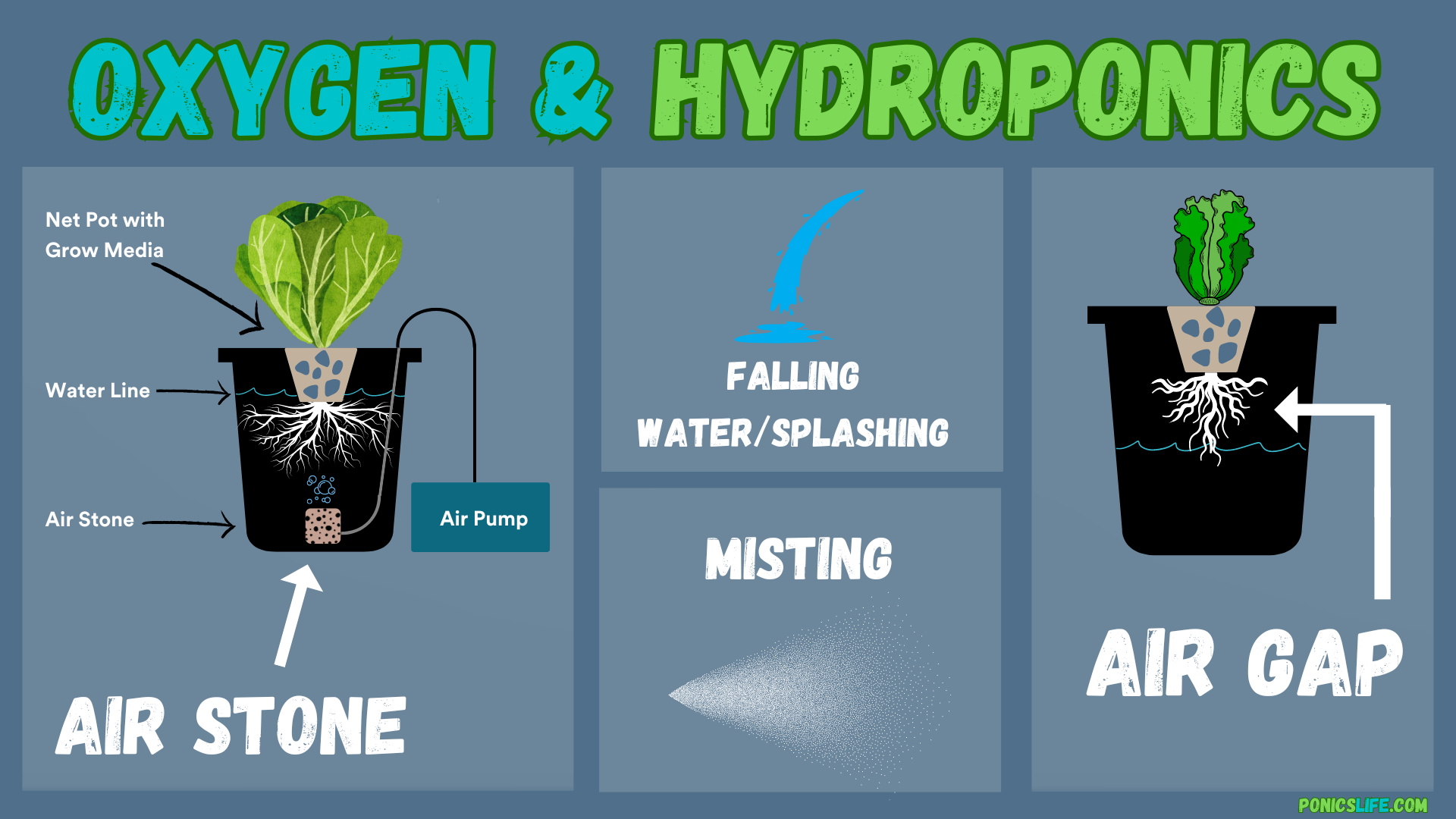Welcome to the Hydroponics Hobby Center
Explore the Ponics Life Hydroponics Hobby Center for the latest and greatest hydroponic information!
What is Hydroponics?
Hydroponics is the process of growing plants in water using liquid nutrient solutions instead of soil. This approach enables precise control over environmental conditions, such as nutrient levels, lighting, temperature, and humidity, leading to enhanced plant growth, increased yields, and more efficient use of resources.
By eliminating soil, hydroponics reduces water consumption, cuts down on the use of pesticides, and allows cultivation in spaces where soil quality is poor or unavailable, including urban settings, regions with adverse agricultural conditions, or even in the limited space of an apartment. As a hobby, small-scale hydroponic systems can support a diverse range of plants, offering a sustainable and versatile solution for year-round gardening. This method not only addresses challenges of limited arable land and water scarcity but also promotes healthier and faster-growing plants in your own home, making it a popular choice for hobbyists seeking to optimize their garden-grown fruits and vegetables.
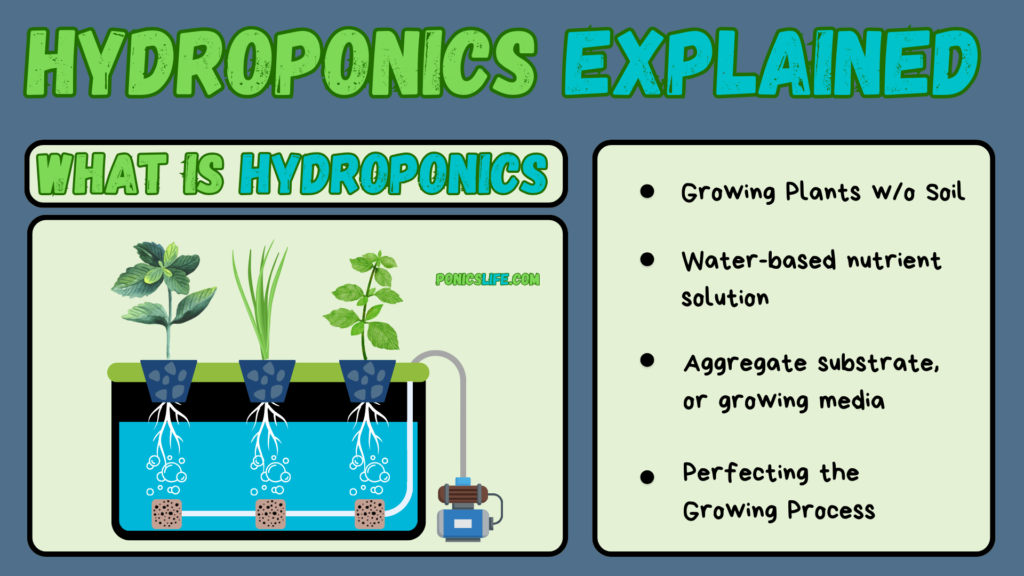
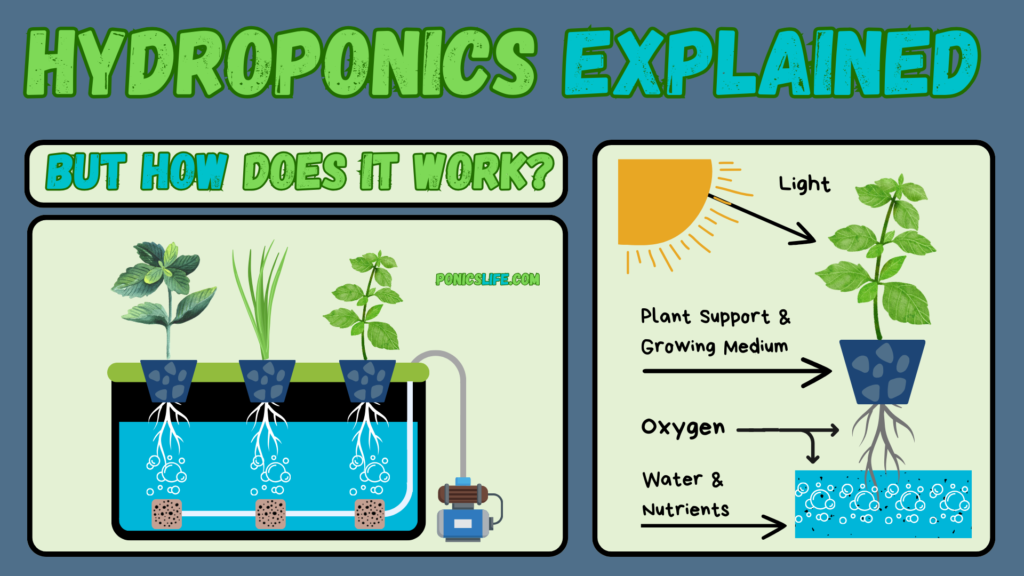

Active vs Passive Systems
Passive and active hydroponic systems represent two fundamental approaches to soil-less plant cultivation, each with its distinct mechanisms for delivering nutrients and oxygen to plant roots.
Passive hydroponic systems rely on natural processes to transport water and nutrients to the plants. They do not use any moving parts, such as pumps or aerators, making them simpler and more cost-effective to operate. The wick system is a prime example, where capillary action draws nutrient solution from a reservoir to the plant roots through a wick. Passive systems are ideal for beginners or those looking for low-maintenance gardening options, though they may be less efficient for larger plants or those with high nutrient and water demands.
Active hydroponic systems, on the other hand, use mechanical means to ensure that nutrient solution is actively delivered to the plants. These systems often involve pumps and timers to circulate water and nutrients, providing a more controlled and efficient environment for plant growth. Examples include the Nutrient Film Technique (NFT), Deep Water Culture (DWC), and aeroponics, all of which allow for precise management of nutrient delivery and oxygenation to the root zone. Active systems are typically more complex and costly than passive systems but offer higher yields and are more suitable for a broader range of plant types.
Both passive and active hydroponic systems have their place in the world of hydroponics, with the choice between them depending on the grower's resources, expertise, and the specific needs of the plants being cultivated.
Outdoor vs Indoor Hydroponics
Outdoor and indoor hydroponics are two environments that offer unique advantages and challenges for the cultivation of plants without soil. Outdoor hydroponic systems leverage natural sunlight, which is an efficient and cost-effective light source for plant growth. These systems can be less expensive to set up initially, as they often require fewer artificial inputs for lighting and climate control. However, outdoor hydroponics are subject to the variability of weather conditions, seasonal changes, and potential pest and disease exposure, requiring growers to be more vigilant in monitoring and protecting their crops.
Indoor hydroponics, on the other hand, offers complete control over the growing environment, including temperature, humidity, light intensity, and photoperiod, thanks to artificial lighting (such as LED lights) and climate control systems. This control enables year-round cultivation, unaffected by external weather conditions, and significantly reduces the risk of pests and diseases. While indoor systems can be more costly to set up and operate due to the need for electricity and equipment, they often result in higher yields and faster growth rates due to the optimized conditions.
Both outdoor and indoor hydroponics have their merits, with the choice between them depending on factors like climate, available space, budget, and the specific requirements of the plants being grown. Outdoor systems can be ideal for larger-scale operations or in climates that are favorable year-round, while indoor systems are suited for urban environments, areas with harsh weather conditions, or growers seeking maximum control over their cultivation environment.
Benefits of Hydroponics
Hydroponics offers a multitude of benefits over traditional soil-based cultivation, making it an increasingly popular choice for farmers and hobbyists alike. This innovative method of growing plants in a water-based, nutrient-rich solution enables faster plant growth, higher yields, and year-round production, irrespective of seasonal constraints.
One of the key advantages of hydroponics is water efficiency; it uses significantly less water than conventional agriculture (between 70-90% less), as the system recirculates water, reducing waste and conserving this precious resource. Moreover, hydroponics allows for greater control over the growing environment, including nutrient levels, pH balance, temperature, and moisture, leading to healthier plants with reduced need for chemical pesticides and herbicides. The versatility of hydroponic systems means they can be set up in a variety of spaces, from small indoor areas to large greenhouses, making it an accessible option for urban settings where space is limited.
Additionally, by eliminating soil, hydroponics reduces the risk of soil-borne diseases and pests, further contributing to its efficiency and sustainability as a farming method. With the adoption of energy-efficient lighting and advancements in hydroponic technology, it's becoming an even more attractive option for producing fresh, high-quality produce closer to consumers, reducing transportation costs and environmental impact.
Latest Hydroponic Articles
Hydroponic Systems
Explore the 6 Basic Types of Hydroponic Systems (Plus Kratky!)
Every System is Unique
There are 6 basic types of hydroponic systems (plus the honorable Kratky!) and thousands of variations. When designing and building your own system, we recommend that you start with something easy — such as Deep Water Culture — and then gradually move up to more complex systems. And remember, every system is unique and has its own advantages. If something isn’t working for you (whether space, parts, affordability, etc.), don’t give up! Just try something easier and keep on building and experimenting. As you’ll quickly find out, hydroponics is truly a trial and error kind of hobby and it can take some time to get the hang of things.
To learn more about hydroponic systems, try reading our ‘Types of Hydroponic Systems‘ Guide or explore the dropdowns below.

The Wick System
The Wick System is one of the simplest forms of hydroponics, a method of growing plants without soil by using mineral nutrient solutions in a water solvent. This passive hydroponic system works by using a wick, typically made from materials like cotton or felt, to draw nutrient-rich water from a reservoir to the growing medium where the plants are situated. Due to its simplicity and the fact that it doesn't require any electricity or moving parts, the Wick System is especially popular among beginners or for small-scale hydroponic setups.
Plants are placed in a porous medium that allows for effective capillary action, such as coco coir, perlite, or vermiculite, which facilitates the transfer of the nutrient solution from the reservoir to the roots of the plants. This ensures that the plants receive a steady supply of water and nutrients, which can lead to faster growth rates and higher yields compared to traditional soil gardening.
Deep Water Culture (DWC)
Deep Water Culture (DWC) is a highly efficient hydroponic farming method where plants' roots are suspended in a nutrient-rich oxygenated water solution, allowing for rapid growth and high yields. In this system, each plant is held in a net pot or basket, with the roots dangling directly into a water reservoir below. The key to DWC's effectiveness is the continuous oxygenation of the nutrient solution, typically achieved using an air pump and air stone, similar to an aquarium setup. This constant supply of oxygen to the roots is crucial for preventing root rot and encouraging vigorous root growth.
DWC is favored for its simplicity and effectiveness, particularly suitable for growing leafy greens and herbs, though it can be adapted for a wide range of plants. It allows for greater control over the plant's environment compared to traditional soil gardening, leading to faster growth rates and potentially larger yields. The system is relatively easy to set up and manage, even for beginners, and because the plants are grown in a controlled environment, they are less likely to encounter pests and diseases.
Nutrient Film Technique (NFT)
The Nutrient Film Technique (NFT) is a popular and efficient hydroponic system that allows plants to grow with their roots exposed to a thin film of nutrient-rich water. This method involves a continuous flow of water over the roots within a shallow channel or tube, ensuring the plants receive an uninterrupted supply of water, oxygen, and nutrients. The water is recirculated from a reservoir, making NFT an economical and water-efficient growing method.
NFT systems are particularly well-suited for leafy greens and herbs, but they can support a variety of plants, provided the system is properly managed. One of the main advantages of NFT is the system's ability to provide optimal oxygenation and hydration directly to the roots, promoting rapid growth and high yields. Additionally, because the nutrient solution is constantly recirculated, it uses water and nutrients more efficiently than many other hydroponic methods.
Setting up an NFT system can be relatively simple, involving the construction of channels for the plants to sit in and a pump to circulate the nutrient solution. However, it requires careful monitoring to maintain the right nutrient balance and flow rate, ensuring the thin film of water is continuous but not too deep, to prevent drowning the roots or depriving them of oxygen.
Despite these considerations, the Nutrient Film Technique remains a favorite among hydroponic growers for its effectiveness, efficiency, and the high level of control it offers over the growing environment.
To learn more, explore our Nutrient Film Technique (NFT) Guide, which covers the system in more detail.
Ebb and Flow (Flood and Drain)
The Ebb and Flow system, also known as the Flood and Drain system, is a versatile and efficient hydroponic growing method where plants are periodically flooded with nutrient-rich water and then allowed to drain. This process ensures that the roots receive ample nutrients and oxygen as the water recedes. Plants are typically grown in pots filled with an inert growing medium, such as clay pellets or rockwool, which supports the roots and retains moisture.
The cycling of flooding and draining is controlled by a timer that activates a pump, submerging the plant roots in the nutrient solution at regular intervals before draining back into the reservoir. This method mimics natural wet-dry cycles, promoting healthy root growth and minimizing the risk of diseases associated with overwatering. The Ebb and Flow system is known for its simplicity, efficiency, and suitability for a wide variety of plants, from leafy greens to larger fruiting vegetables.
Drip System
The Drip System is a highly efficient and widely used hydroponic method that delivers nutrient-rich water directly to the roots of plants through a network of drip emitters or drippers. This system can be set up in a recirculating or non-recirculating (run-to-waste) configuration, making it adaptable to a variety of growing conditions and preferences. In the recirculating setup, excess nutrient solution drains back into a central reservoir for reuse, while in a non-recirculating system, the runoff is discarded, ensuring that plants always receive fresh nutrients.
One of the main advantages of the Drip System is its precision and efficiency in water and nutrient use, as it allows for targeted irrigation directly at the root zone of each plant. This precision reduces water and nutrient wastage and allows for individual adjustments to meet the specific needs of different plants within the same system. The Drip System is suitable for a wide range of plant types and sizes, from small herbs to large fruiting vegetables, making it popular among both hobbyists and commercial growers.
The system's flexibility in design and operation also enables growers to optimize their setups for specific environmental conditions, plant types, and growth stages. However, it does require careful monitoring and maintenance to prevent clogging of the drip emitters and to ensure the nutrient solution is correctly balanced. Despite these considerations, the Drip System remains a favored choice for its efficiency, scalability, and the high level of control it offers over the growing environment.
To learn more, explore our Drip System Guide, which covers the system in more detail.
Aeroponics
The Aeroponics System is a cutting-edge hydroponic technique that grows plants in an air or mist environment without the use of soil or an aggregate medium. In this highly efficient system, the roots of the plants are suspended in the air and periodically misted with a nutrient-rich water solution. The key component of an aeroponic system is the misting mechanism, which needs to finely atomize the nutrient solution to ensure that the plant roots can absorb the nutrients and oxygen they require for growth.
Aeroponics is renowned for its rapid growth rates, high yields, and efficient use of water and nutrients. Since the roots are exposed to more oxygen compared to traditional hydroponic systems, plants tend to absorb nutrients more efficiently, leading to faster growth and healthier plants. This method also minimizes the risk of diseases and pests, which are more common in soil-based and other hydroponic systems.
One of the significant advantages of aeroponics is the conservation of water and nutrients, as the closed-loop system recirculates the mist, reducing waste. Additionally, because the plants can be spaced closer together compared to traditional farming, aeroponics is an excellent choice for urban farming and indoor cultivation, where space is at a premium.
However, the system's reliance on technology means that it can be more complex and expensive to set up and maintain than other hydroponic systems. It requires precise control over the nutrient solution's composition, misting frequency, and duration to ensure optimal plant growth. Despite these challenges, the Aeroponics System is celebrated for its sustainability, efficiency, and the ability to produce high-quality produce in controlled environments.
To learn more about aeroponics, explore our Aeroponics Guide, which covers the system in more detail.
The Kratky Method
The Kratky Method is a remarkably simple, yet effective form of hydroponics that allows plants to grow in a nutrient-rich solution without the need for electricity, pumps, or aerators. Named after Dr. B.A. Kratky from the University of Hawaii, who patented the technique, this passive hydroponic system is ideal for small-scale gardeners or those interested in low-maintenance hydroponic gardening.

The Hydroponic Basics
Learn the Hydroponic Basics: Light, Oxygen, Nutrients, Water
Understanding and managing these four components effectively is key to successful hydroponic gardening, allowing for faster growth rates, higher yields, and healthier plants compared to traditional soil-based gardening.
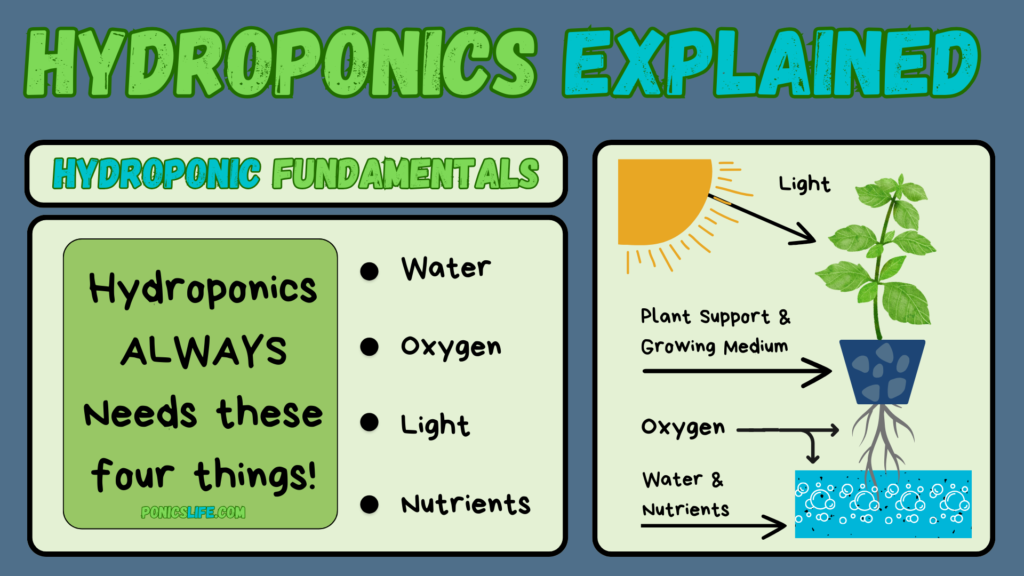
Understanding the Hydroponic Fundamentals
The fundamentals of hydroponics can be summarized into four critical components: light, oxygen, nutrients, and water. Light, whether from natural sources or artificial lighting systems, is crucial for photosynthesis, enabling plants to convert light energy into chemical energy. Oxygen, vital for root health and nutrient absorption, is supplied through various means depending on the hydroponic system, such as air stones in deep water culture or the natural air gap in the Kratky method. Nutrients, typically missing in water, are added in a soluble form, tailored to the specific needs of the plant, ensuring they receive the right balance of minerals required for growth. Finally, water serves as the medium through which plants absorb these nutrients, playing a critical role in plant hydration and the transport of nutrients to the roots.

Water in Hydroponics
In hydroponics, water acts as the lifeblood of the system, serving as the primary medium through which plants access essential nutrients for their growth and development. Unlike traditional soil-based cultivation, hydroponics relies on a nutrient-rich water solution to provide plants with a balanced diet of minerals and trace elements. This direct delivery system allows for more efficient use of water and nutrients, reducing waste and potentially leading to faster growth rates and higher yields.
Water in hydroponics must be carefully managed to maintain the proper nutrient concentration, pH level, and temperature to optimize plant health and productivity. The pH level, typically maintained between 5.5 and 6.5, ensures nutrient availability and absorption, while the temperature of the water influences oxygen solubility, with cooler temperatures generally holding more oxygen. Regular monitoring and adjustments are crucial to prevent imbalances that can stress plants or lead to nutrient deficiencies.
Furthermore, the recirculation of water in many hydroponic systems enhances water efficiency, making hydroponics a more sustainable option compared to traditional agriculture, especially in water-scarce environments. Through the meticulous management of water and its components, hydroponic gardening facilitates the cultivation of plants in controlled environments, leading to clean, consistent, and often superior produce.
To learn more, explore our Hydroponics Water Quality Guide, which will go into more detail.
Oxygen in Hydroponics
Oxygen plays a crucial role in hydroponic systems, underpinning the health and efficiency of plant root systems and their ability to absorb nutrients and water. In the soilless environment of hydroponics, oxygen is primarily supplied to the roots through the nutrient solution. Adequate oxygenation is essential for supporting aerobic respiration, where roots convert sugars and oxygen into energy, facilitating vigorous plant growth and resilience against root diseases.
Methods to enhance oxygen levels in hydroponic setups typically include the use of air stones and pumps, similar to those in aquariums, to infuse the water with oxygen, creating a bubbly environment that ensures roots receive ample oxygen. Then there are systems like Aeroponics, which is explicitly designed for maximum oxygen exposure, by misting roots with an oxygen-rich nutrient solution.
The importance of oxygen in hydroponics cannot be overstated, as it directly impacts nutrient uptake, plant growth rates, and overall plant health. A well-oxygenated root zone enables plants to efficiently absorb the nutrients and water they need, leading to healthier, more productive plants. Therefore, maintaining optimal oxygen levels in the nutrient solution is a critical aspect of successful hydroponic gardening.
Important Notes:
- In hobby setups, there's really no such thing as too much oxygen. The more the better!
- There are multiple ways to oxygenate your plant's roots, including an air stone and air pump (most common), falling water, misting, splashing, an air gap (Kratky is a great example here), or a venturi system.
To learn more about oxygen in hydroponics, read our full guide on oxygen in hydroponics which includes additional details/diagrams on 5 different oxygenation methods.
Light in Hydroponics
Light is a fundamental component of hydroponic systems, serving as the primary energy source for plant photosynthesis, the process by which plants convert light energy into chemical energy to fuel growth and development. In hydroponics, where natural sunlight might be limited or inconsistent, artificial lighting systems such as LED (Light Emitting Diodes), HID (High Intensity Discharge) lamps, and fluorescent bulbs are commonly used to provide the necessary light spectrum and intensity for optimal plant growth.
For hobbyists, LED lighting stands out as the recommended choice, owing to its energy efficiency, longevity, and the ability to tailor light spectra to specific plant needs. LEDs provide a significant advantage by emitting less heat compared to traditional HID (High Intensity Discharge) lamps or fluorescent bulbs, reducing the risk of heat stress on plants and allowing for closer placement to the foliage for optimal light absorption.
The quality of light, including its spectrum, intensity, and duration, must be tailored to the specific needs of the plants being grown. Different stages of plant growth require different light spectrums; for example, blue light promotes vegetative growth while red light encourages flowering and fruiting. The intensity of the light affects how well the plants can photosynthesize, and the duration, or photoperiod, influences their growth cycle and when they enter various growth stages.
Proper management of light in hydroponic systems ensures that plants receive the right amount of energy for photosynthesis, leading to healthy, robust growth even in environments where natural sunlight is insufficient. By mimicking the optimal light conditions for plants, hydroponic gardeners can achieve year-round production of high-quality, nutritious produce regardless of outdoor weather conditions or geographical location.
Important Notes:
- While outdoor hydroponic plants need the same amount of direct sunlight as their soil-based cousins (see our "How Much Sun do Vegetables Need" guide), most indoor plants like somewhere between 12 and 18 hours of light.
- Seedlings prefer 16-18 hours of light.
- Lettuce and herbs prefer about 12-14 hours (but of course, do your own trial and error!)
- For Seedlings, keep your grow lights about 4 to 6 inches above your canopy.
- Once your vegetables have a few true leaves, you can push this back to 6 to 12 inches.
Nutrients in Hydroponics
Nutrients in hydroponics are essential for plant growth and development, replacing the natural minerals and trace elements found in soil with a carefully balanced, water-soluble nutrient solution. This solution contains all the essential elements plants need, including nitrogen, phosphorus, potassium, calcium, magnesium, and sulfur, along with a range of micronutrients like iron, manganese, copper, zinc, and boron. Each of these elements plays a critical role in plant health, supporting various functions from energy production and photosynthesis to the development of strong roots, stems, leaves, and fruits.
In hydroponic systems, the nutrient solution is directly available to the plant roots, allowing for more efficient use and uptake of nutrients compared to traditional soil-based gardening. This direct feeding can lead to faster growth rates, higher yields, and more vibrant plants, as long as the nutrient solution is carefully managed to maintain the right concentration and balance of nutrients.
Adjusting the nutrient solution's pH (usually between 5.5 and 6.5) is also crucial, as it affects the availability of nutrients to the plants. Regular monitoring and adjustments ensure that plants receive the optimal conditions for nutrient uptake. The precision and control over nutrient delivery are what make hydroponics an effective method for producing healthy, high-quality plants.
To learn more, explore our Hydroponic Nutrients Guide, which will cover the topic in more detail.
Important Notes:
- Hydroponic Nutrients come in two forms, dry (powder) and water-based (mixed in). Dry nutrients (which are typically used by more experienced growers), will provide a much longer shelf-life.
- For beginners, it's best to follow the bottles instructions or look up your brand's feed chart (which will be online) when adding in nutrients.
Other Important Considerations
Reservoir Temperature
Maintaining the optimal temperature of the nutrient solution in hydroponic systems is crucial for the health and growth of your plants. The ideal range for most hydroponic crops is between 68-72°F (20°C to 22.2°C). This temperature range ensures that your plants can effectively absorb nutrients and oxygen, fostering robust growth and development. While it's possible to slightly extend this range to 68-75°F (20-24°C) without significant negative effects, it's important to avoid more extreme temperatures. Nutrient solutions that exceed 80°F (27°C) or drop below 60°F (16°C) can lead to poor plant growth.
High temperatures can reduce oxygen levels in the water, increasing the risk of root diseases and stress, while low temperatures can slow plant metabolism and nutrient uptake, stunting growth. Careful monitoring and regulation of reservoir temperature are therefore essential practices in hydroponics to ensure optimal plant health and productivity.
Hydroponic Substrates and Growing Mediums
Hydroponic growing mediums are essential in supporting plant growth without soil, providing stability and aiding in the efficient delivery of water, nutrients, and oxygen to the roots. These inert materials are chosen for their ability to maintain a balance between moisture and air, crucial for healthy root development.
Among the popular options are clay pellets or lightweight expanded clay aggregate (LECA), which are favored for their lightweight nature and excellent drainage and aeration capabilities. Coco coir, derived from coconut husks, is a sustainable and pH-neutral choice that perfectly balances moisture retention with adequate air space. Perlite and vermiculite are also widely used, both for their lightweight properties and their capacity to retain water effectively.
Selecting the appropriate hydroponic growing medium is key to ensuring the root zone's health, efficient nutrient absorption, and overall success in hydroponic gardening, catering to various plant needs and system designs.
For a full breakdown of available hydroponic growing mediums that highlights advantages, disadvantages, and aeration properties, give our Hydroponics Growing Medium Guide a read.
DIY Stories
Have you built your own hydroponic system? WE WANT TO SHARE YOUR PROJECT! If you’re proud of your setup and want to share it with the Ponics LIfe community, add your story and your pictures to our easy-to-fill-out form so we can get your setup published!
Hydroponic Vegetable Guides
Learn How to Grow Vegetables Hydroponically
Grow Anything in Hydroponics
Hydroponic systems can support a wide range of vegetables, from leafy greens like lettuce and spinach to larger, fruit-bearing plants such as tomatoes, cucumbers, and peppers. The controlled environment of hydroponics not only allows for year-round harvesting, regardless of external weather conditions, but also significantly reduces the use of water and eliminates the need for pesticides and herbicides, leading to cleaner, more sustainable produce. Hydroponic vegetables are known for their vibrant colors, rich flavors, and nutritional content, making them a preferred choice for health-conscious consumers and those interested in reducing their environmental footprint. With the advancements in hydroponic technology, including the widespread availability of energy-efficient LED lighting, hobbyists and commercial growers alike can enjoy the benefits of soil-less cultivation, bringing fresh, high-quality vegetables from farm to table with minimal environmental impact.
Hydroponic Celery
Learn everything there is to know about Hydroponic Celery here!
Hydroponic Lettuce
Learn everything there is to know about Hydroponic Lettuce here!
Hydroponic Green Onions
Learn everything there is to know about Hydroponic Green Onions here!
Hydroponic Basil
Learn everything there is to know about Hydroponic Basil here!
Hydroponic Kale
Learn everything there is to know about Hydroponic Kale here!
Hydroponic Cucumber
Learn everything there is to know about Hydroponic Cucumber here!
Hydroponic Broccoli
Learn everything there is to know about Hydroponic Broccoli here!
Hydroponic Spinach
Learn everything there is to know about Hydroponic Spinach here!
Hydroponic Bok Choy
Learn everything there is to know about Hydroponic Bok Choy here!
Hydroponic Cabbage
Learn everything there is to know about Hydroponic Cabbage here!
Important Charts and Information
Important charts and information that will help you grow!
Hydroponics pH, EC, PPM Chart
The water in your hydroponic reservoir has to stay within certain parameters to ensure your plants grow healthy and happy. To explore those parameters -- to inlcude pH, EC, and PPM -- read our Hydroponics pH, EC, and PPM Guide which includes a full, easy-to-read chart.
Companion Planting
Companion planting is more relevant to soil-based gardening, but it's nonetheless an important topic to explore if you're doing outdoor hydroponics. To learn more about the theory of vegetable pairing (aka companion planting), explore our Hydroponics Companion Planting Guide With Chart.
Vegetable Container Sizes
Enter the world of container gardening and explore the minimum container volumes for common vegetables. The knowledge shared here will equip you with the necessary insights to grow a flourishing container garden, no matter your space limitations or personal taste. Read our Vegetable Container Size Standards Guide with Chart to learn more.
Seed Germination Time and Temperature
There are several environmental conditions that influence seed germination in hydroponics: overall seed condition, the presence of water, the presence of oxygen, what type of growing medium you’re using, and temperature. To Learn more, explore our Seed Germination Time and Temperature Guide with Chart.
Shallow Root Vegetables
While there are some systems built for larger vegetables, shallow-rooted vegetables can typically be grown in any type of system. Read our Shallow Root Vegetables Guide to see which vegetables are best for your setup.
Aeroponic Rooting and Cloning Time
Aeroponics is the fastest and most efficient way to propagate and clone plants. If you interested in learning the amount of time it takes (general ballpark estimate) for each plant to take root, explore our Cloning Time for Aeroponic Vegetables Guide with Chart to learn more.
Hours of Sunlight Needed for Plants
When growing outside, your plants are going to need a minimum amount of hours under the sun. And because each plant is different in their "amount of sun" needs, we've outlined a detailed list of sunlight requirements for commonly grown vegetables. To learn more, explore our Vegetable Sunlight Hours Guide With Chart.
Days to Maturity (Harvest and Transfer) for Common Vegetables
This quick guide offers a thorough chart detailing optimal transplant times and days to maturity for various vegetables. To learn more, explore our When to Transplant and Harvest Vegetables Guide with Chart.
Seed Planting Depth and Spacing
When growing plants, you'll find that seeds prefer to be planted at a certain depths to germinate. Additionally, if growing outside, they'll need to be spaced appropriately to accommodate their size at maturity. To learn more, explore our Seed Planting Depth and Spacing Guide with Chart.
Storing and Preserving Vegetables
After harvesting your hydroponically grown vegetables, you have two options: You can eat them right away or you can store them for a short period of time. If you're wanting to store them, then it's important that you do everything possible to keep their freshness. To learn more, explore our Storing and Preserving Vegetables Guide with Chart to learn more.
Using Safe Plastic in Hydroponics
Not all plastic is created the same way and some plastic is better to use than others. If you'd like to learn more about using plastic in your hydroponic systems -- what's safe and what's not -- then explore our Food Grade Plastics Guide to learn more.
Planting Zones
If you live in the US and you plan on growing outdoors, you'll need to pay attention to your USDA Hardiness Zone, as that will largely determine when/what you can grow. To learn more, check out our Vegetable Planting Calendars.
Shade Tolerant Vegetables
Knowing which vegetables will grow well in the shade is important if you're doing outdoor hydroponics. Read our Shade-Tolerant Vegetables Guide to learn more.
Roots and Hydroponics
While root health in hydroponics might seem straightforward, there's actually a lot to it. Read our Roots and Hydroponics Guide to learn everything there is to know about roots (structure, health, root rot, etc.).

